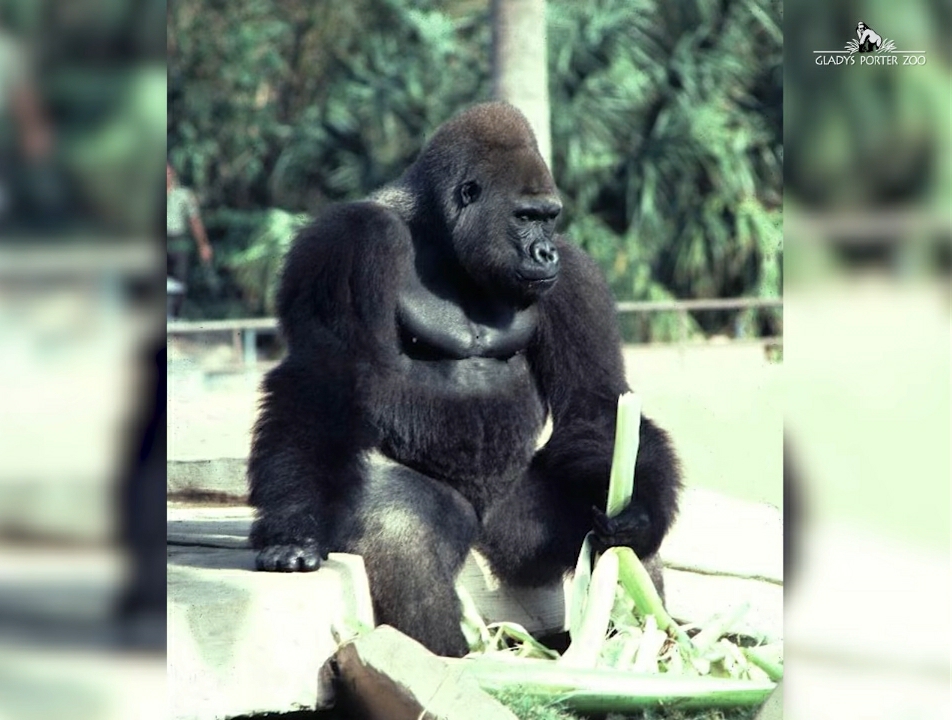- South Texas Students Meet Accordion Music Icons Los Tigres Del Norte In Edinburg Thanks To Khs America/Hohner Alianza Académica Initiative
- Fragile Planet Offers a Nighttime Wildlife Experience
- Falcons Soccer Off & Running
- Cameron County Receives Funds to Improve Two Parks
- Falcons Complete First Half of 32-6A
- School District to Help out Victims of California Wildfires
- Sand Castle Days Continued Despite Unexpected Weather
- Ready for District
- Discussion of Garbage Dumpster Rates, Agreements Between State & City on Highway Regulations, and More
- 31st Annual Shrimp Cook-Off is Right Around the Corner
The Passing of an Iconic Gorilla Patriarch
- Updated: March 13, 2022
BROWNSVILLE, Texas (February 24, 2022)—Gladys Porter Zoo staff are mourning the passing of Lamydoc (pronounced luh-MY-dok), the patriarch of the Zoo’s multi-generational Western lowland gorilla troop. On the afternoon of February 22nd, Lamydoc was humanely euthanized due to declining health. He was estimated to be approximately 60 years old, well past the average life expectancy for Western lowland gorillas.
In the wild, the life expectancy for lowland gorillas is only 30 to 40 years. In human care, they can live beyond 50 years . . . and, in Lamydoc’s case, much longer.
“Heart disease, which is common in older gorillas, was detected in Lamydoc about ten years ago,” said Dr. Tom deMaar, the Zoo’s Senior Veterinarian. “We supported his condition medically, just as in human medicine. Additionally, over the past two years, he has been demonstrating symptoms of progressive dementia. Although there was never any evidence that he was experiencing pain, it was obvious that his quality of life was deteriorating with no possibility of improvement.”

Lamydoc arrived at the Gladys Porter Zoo in July 1970 at the estimated age of eight. He was accompanied by Katanga, a young female who became his lifetime mate and companion until her euthanasia in 2015 due to cancer. Between 1972 and 1991, Lamydoc sired 11 healthy baby gorillas. Two of them, Martha and Penney, still remain part of the Zoo’s gorilla troop, and are currently caring for youngsters of their own. Others joined gorilla troops elsewhere, including Mary, who lives at Busch Gardens, Tampa, and Casey II, at the Louisville Zoo.
“Lamydoc was the Gladys Porter Zoo’s original silverback and the inspiration for the Zoo’s logo,” said Dr. Pat Burchfield, the Zoo’s Executive Director. “To those of us who were here the day he arrived, he was a solid reflection of the consummate dominant male gorilla. He was independent, confident and full of bravado – the most magnificent male Western lowland gorilla we have ever seen.”
In 2012, Lamydoc and Katanga were photographed by world-renowned wildlife photographer, Joel Sartore, leader of National Geographic’s Photo Ark. In order to raise awareness of species in need of conservation, Photo Ark images, including those taken at Gladys Porter Zoo, have been viewed by millions on the internet and at museums and zoos around the world.
Lamydoc’s living legacy is carried on through his offspring and the future generations of Western lowland gorillas descending from his bloodline. It will also live on in the many lives he has touched throughout his long life.
Western lowland gorillas are listed as Critically Endangered by the International Union for the Conservation of Nature (IUCN) Red List of Threatened Species. In the wild, they are threatened by poaching, disease, and most of all, habitat loss and destruction.
The Gladys Porter Zoo is a member of the Association of Zoos and Aquariums (AZA), which sets a high standard for animal care at zoological institutions across the nation. The Zoo also participates in the Gorilla Species Survival Plan (SSP), which seeks to create a sustainable, genetically diverse population of gorillas in human care.



